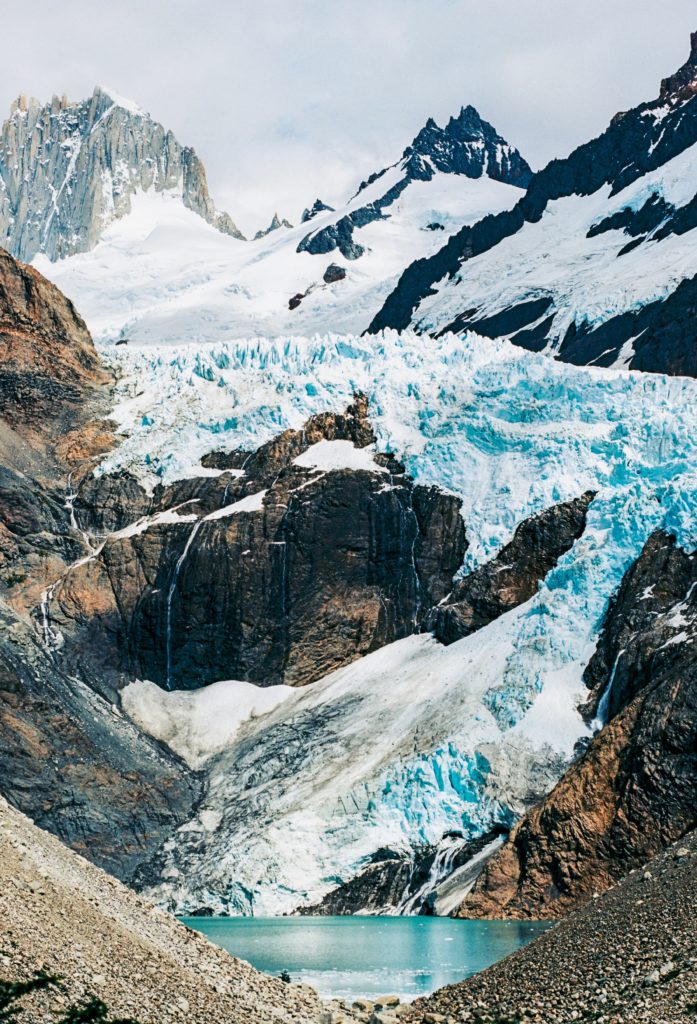The many shapes of water (published in Italian in Osservatore Romano, 21 July 2018)

A glacier is a sea of frozen water. You can reduce the essence of a glacier to that of an ice cube, but you can also see in it a source of life. At the same time, the glacier can pull you in and be a cause of death. This is well known by those who, full of respect and fear, approach the glacier to cross it or just to look at it.
Like an ice cube in a glass, the glacier also slowly dissolves. The dissolution of a glacier can be easily seen and heard when approaching it. There are whole slabs that come off and fall with a roaring sound, but there are also thousands of streams and torrents that gush and fill the valleys with whispers. The smooth surface of black rocks that the glacier have left behind, when withdrawing, seems a sign of death. Yet, just below, there are verdant meadows and woods where life pulsates.
Dissolution of the glacier is not disappearance into nothingness, but transformation: the sea of iced water becomes running water and, finally, a salt water sea. This, in turn, sublimates into the air and, falling, becomes icy water again. It is not a vicious cycle. Every form of life comes to a stop in ice, but it is in the water that springs from ice that new life is reborn. In the history of the earth, glaciations played an essential role in the composition and evolution of the various forms of life and their geographical distribution, the last one happening only 10,000 years ago.
But what is the “reality” of water for those involved in physics and chemistry and what is its importance for biochemistry? What is the reality of ice and what role do temperature variations play in the physical-chemical processes on which the vital ones depend? Who writes knows little of physics and chemistry, but uses fundamental concepts of these disciplines to explain to his students in Medicine the mechanisms of life. He does this starting right from water.
The water molecule is not a simple sum of two hydrogen atoms and one of oxygen. To hold together these atoms are electrons, negatively charged particles that these atoms put in common and that envelop them as in a cloud. Certain atoms exert more “attraction” to electrons than others. It is so for oxygen and hydrogen, in the water molecule the distribution of electrons around the core of oxygen is more dense than that around the hydrogen. The water molecule is therefore asymmetric, with a polar charge distribution. As everyone knows, opposites attract each other. This holds true for the innumerable water molecules that lie next to each other, the positive pole of one attracting the negative pole of the other. So water is actually a floating network of molecules that the low temperature stabilizes in crystals.
The definition of the covalent chemical bond and of weak electrostatic interactions between atoms and molecules in the last century led to a unified vision of physics and chemistry, which led to the jump to biochemistry, genetics and molecular biology. A key moment was the discovery, in 1953, of the double helix structure of the DNA molecule, composed of two long complementary chains made of a variable sequence of monomeric units, encoding the genetic information of all living organisms. The DNA structure was discovered thanks to the study of the imprint left by X-rays that had been passed through DNA molecules arranged in a fixed spatial orientation through “crystallization”. In interpreting the complex results of this technology, a revealing moment was the realization that the DNA structure is based on the same type of electrostatic interactions that connect water molecules and that water itself plays a determining role in the structure of DNA, as a kind of cage that envelops it.
Water plays a similar decisive function in the structure and maintenance of cells, the fundamental units of every living being. The membranes that separate one cell from the other and that, inside a cell, delimit various compartments are formed thanks to electrostatic interactions and forces of repulsion with the surrounding water molecules that form, also in this case, a cage . This type of interactions between organic molecules and water may have also been at the origin of the first vital forms, which are traced back several billion years ago and of which nothing precise is known.
While in all these cases water molecules function as a flexible net that surrounds and shapes other molecules around which it adapts, there are other cases, equally important, in which single water molecules work in isolation from all others and, for this reason, become highly “reactive“. It is the case of water molecules present in “internal pockets” of many enzymes, proteins responsible for most of the biochemical work of cells and organisms. In these situation, the cloud of electrons that surrounds the single water molecule is unstable and can “attack” and be transferred to atoms of other surrounding molecules, causing a chain reaction such as that involved, for example, in food digestion.
Is this brief excursus just on the “biophysics of water” ? For those dealing with “metaphysics“, what is the point of thinking about these physical things while they are going after realities that “are beyond”? It is easy to think that the water of life that Jesus offers to the woman at the spring is an entirely different thing than the water that the woman went to fetch and that Jesus asked her to drink. Yet, is it not possible that both forms of water have the same foundation and that, by giving water to someone who is thirsty, the spirit is also restored ? What is the water of life that gushes from the pierced side of Christ? I leave these questions suspended up in the summer air, for those who may have some time to go out and venture into unknown spaces, even if a bit dangerous, like those who venture up towards a glacier.
